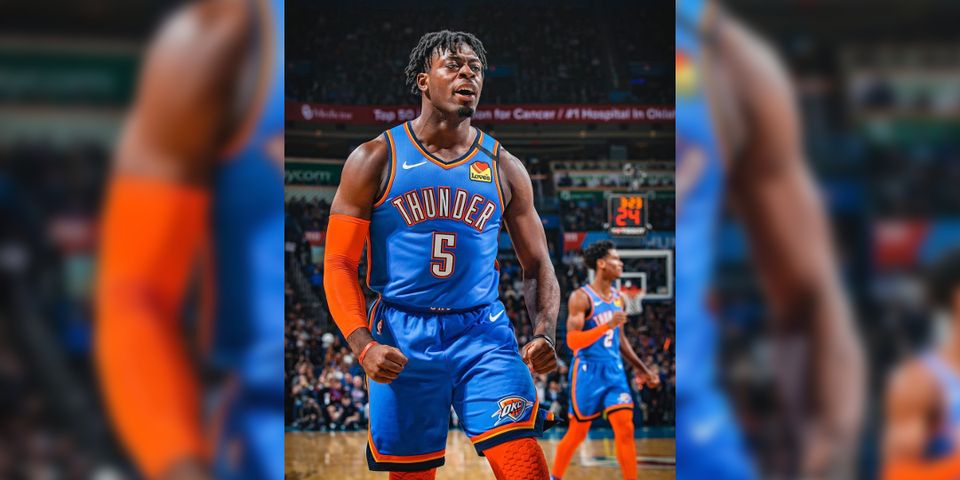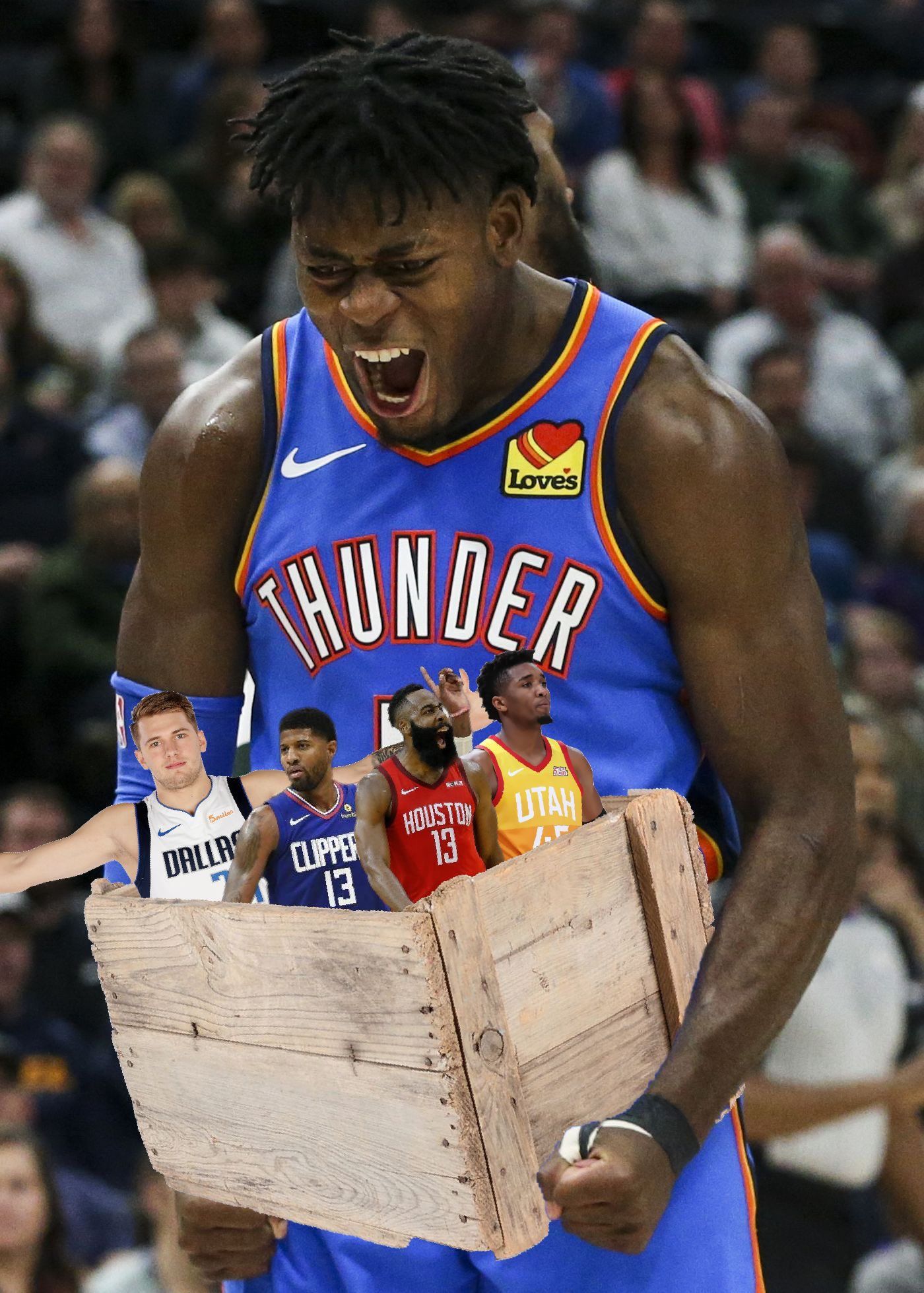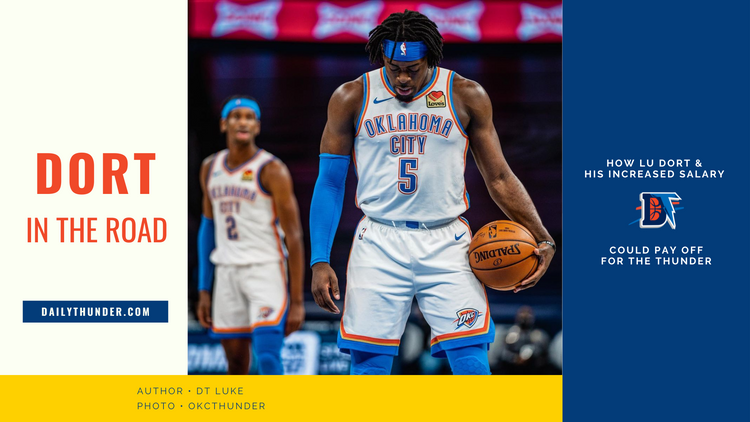Dort Knox: Just How Good Is Lu’s Defense?

Not many undrafted rookies see significant playing time on playoff teams, but Luguentz Dort, undrafted out of Arizona State, broke into the Thunder rotation and even took over the starting spot in late January. Since he broke into the rotation, the Thunder are 19-6 with the fifth best net rating in the NBA (+5.5). Dort has gained a reputation as a lockdown defender after games where he’s been tasked with guarding James Harden and Donovan Mitchell in big Thunder wins. But how much is he really helping the team’s defense, and how much of the hype is just social media buzz and highlights?
On the ball
Let’s start with the good. On an individual level, Dort absolutely shows some prowess as a strong on ball defender. He’s not exactly tall for his position, but he’s built and can hold position well. He’s got active hands, fights around screens, and plays with a ton of energy. At the very least, you can see promise for the rookie. Here he is on Donovan Mitchell:
Dort starts out fighting around a screen from Tony Bradley, counters Mitchell’s change of direction, gets around Bradley again (who acts as a moving screener while cutting) to recover to Mitchell and hold his position without biting on a pump fake. All of this is really good for a primary defender and certainly encouraging to see.
All the rest
Defense in basketball is a somewhat difficult topic because we see great on ball defense in clips like that and immediately think that makes someone a great defender. But in most cases, off ball defense is a much larger part of someone’s impact. Even the best of the best offensive players only shoot on maybe thirty percent of their team’s possessions while on court. What you do when your man doesn’t have the ball accounts for the majority of your time on the court as a defender.
Dort has some issues at times following the game away from his man. Here’s a moment from the same game against Utah:
While ball watching, he just sort of loses Mitchell, who cuts to the rim for an easy layup.
Various all-in-one metrics and lineup data can be a bit better measure of overall defensive impact. These look at how well a team performs while a player is on court, adjusting for both quality of teammates and opponents. With this context, we can start to see a player’s combination of on and off ball defense affecting the team.
| D-PIPM | -0.31 |
| D-RAPM | +0.16 |
| Luck-adjusted D-RAPM | -0.08 |
| Defensive RPM | +1.64 |
Dort’s advanced metrics per-100 possessions, via BBall Index, nbashotcharts, and ESPN
Impact Plus-Minus (PIPM) and Regularized Adjusted Plus-Minus (RAPM) view Dort as a roughly neutral defender. Real Plus-Minus (RPM) views him more favorably, likely due to player tracking data inputs (which I’m not a fan of for defensive measures). I’d tend to side right now with the former two, which are more aligned with the performance of Thunder lineups featuring Dort.
He does seem to benefit from some shooting variance, at least on shots he contests (opponents are shooting only 27.3% when he contests a three, as opposed to the expected 35.8%). Statistical studies have shown shooting can be heavily subject to variance, especially in small samples. This variance, rather than how effectively you put a hand up (i.e. “contesting”), might have more to do with the shot going in or not thank you would think.
hand in face had no impact on shot defense back when i did the study in 2007ish.
— Haralabos Voulgaris (@haralabob) August 5, 2020
As a unit
Oklahoma City’s team defense has been slightly worse when Dort is on the floor since he was inserted into the lineup in January. Opponents shoot a bit worse from three when he’s off the court, but that could again be due to the variance factor. The realest impact Dort has made has been with the starters, which is damning with faint praise because of who he’s replaced. Most any metric available measures Terrence Ferguson as a detriment to the team. Luck adjusted RAPM is the only of those above that has the two players even remotely comparable. The others rate Ferguson as one of the most harmful players in the NBA.
There’s an interesting wrinkle to the overall lineup numbers: despite meager, inefficient individual offensive stats, Dort has added more (measurable) value on that side of the court than on defense. This could just be because he’s doing more than standing passively in a corner, where opposing defenses don’t need to do much more than occasionally recognize him. He’s shown an ability and willingness to be aggressive on offense in ways Ferguson hasn’t. At the time of this writing, Ferguson has taken only 15 shots off more than a single dribble this season. Dort, in 400 fewer minutes, has taken 59 such attempts. That gap in aggressiveness likely changes how a defense plans for OKC.

Dort Knox or house of cards?
For an accurate accounting of Lu Dort’s impact on defense, I think we should balance his more average overall metrics against the stronger man-to-man impressions we have. He’s been a fine defender, not a real stand out. Dort might not be a real Defensive Player of the Year candidate yet, or even a high end NBA wing. But there are certainly some building blocks to work with from his man to man defense, strength, and aggression on offense. He’s only a rookie and in his first season has shown some of the ability any team would like to have in a potential long term bench wing.
So is James Harden about to enter a house of pain, or are Thunder fans about to watch the Dort Knox myth crumble?
The signs don’t point to Dort being instrumental in a team-wide smothering like Andre Roberson has anchored in past matchups with Rockets and Warriors juggernauts. But more than any team in the league–and especially without Russell Westbrook for part of the series–Houston will locate much of its action with Dort’s assignment, James Harden. Harden presents a test of just how far along Dort really is as an on-ball defender, and an opportunity for him to make the greatest impact possible on that side of the court.
We’ll see.


